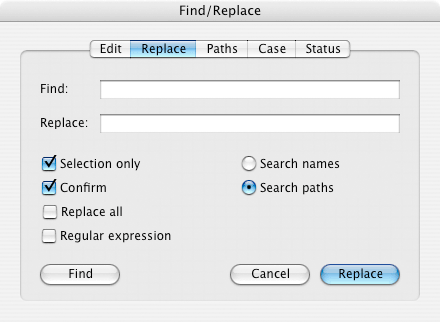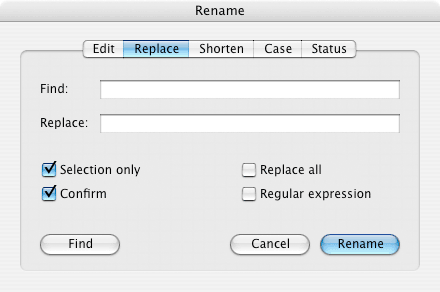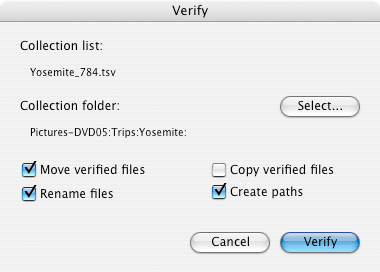
New - Opens a new collection list window.
Open - Opens a picture file or a collection list. Picture files include JPEG, TIFF,.gif, GIF, Photoshop, and other formats. Collection lists contain the names, sizes, CRCs, path and status of files included in a collection. PicTracker's native file format is TSV, but it can read CSV, CRC, and SFV files as well.
Open Folder - Opens a folder of files in the file list window. The file list contains the files to be acted on, including viewing, copying, moving, renaming, and verification.
If the file list is already open, you can either replace the list (default) or you can append new files to the list. If you choose to append files it is important to not add the same files more than once. PicTracker will flag such files with an error status when checking for duplicate files.
Save - Saves changes to a collection list.
Save As - Saves a file list or collection list as a new file.
Save Selection - Saves the selection in a file list or collection list as a new file.
Append - Appends a collection list, used to combine several collection lists into one larger list.
By default a new folder will be created for each appended list. The file name excluding any trailing underscore and following charcters is used as a folder name. For example, appending the file "dogs_37.tsv" will create a folder named "dogs". This option can be turned off in the Preferences dialog.
Append All - Appends all collection lists in a selected folder.
Export - From a file or collection list this saves the list as a CSV file. From the picture window this saves the image as another file type, including JPEG, PICT, BMP, TIFF, GIF, and other formats.
Export Selected - Saves the selection in a file list or collection list as a CSV file.
Clear - Removes the selected files from the list. It does not delete or modify the files.
Select All - Selects all files.
Deselect All - Deselects all files.
Invert Selection - Inverts the file selection state.
Find - Searchs for one or all matching files in the list. May include a regular expression.
Find Next - Searchs for the next matching file in the list.
Replace - Search and replace commands for editing collection lists. These do not change the names of the files, only their references in the collection list. However, editing the collection list is a powerful tool for renaming and reorganizing an entire file collection. After editing file names and paths in the collection list, you can use the Verify command to rename the actual files and move them to new folders.
Edit - Edit the selected file name or path.
Replace - Find or replace text in multiple file names or paths. Leave Selection only checked to limit renaming to selected files, and leave Confirm checked to confirm changes before replacing. Replace all replaces each occurance of the find expression, rather than just the first.
If you check Regular expression PicTracker will do a regular expression find and replace. A full explanation of regular expressions is beyond the scope of this manual, but the following is useful example.
The find expression ".+(\d+)\.gif" and the replace expression "image\1.gif" (excluding the quotes) will rename.gif filenames ending in one or more digits, for example is "pic012.gif" will be renamed "image012.gif". Regular expressions are non-greedy by default and case insensitive.

Paths - Add, delete, or replace folder names in the file paths.
Case - Change case of file names or paths.
Status - Change file status.
Copy Files - Copies the selected files to a specified folder.
Move Files - Moves the selected files to a specified folder.
Rename Files - Allows batch renaming of selected files.
Edit - Renames one selected file.
Replace - Find and replace text in multiple file names. Leave Selection only checked to limit renaming to selected files, and leave Confirm checked to confirm changes before renaming. Replace all replaces each occurance of the find expression in the file name, rather than just the first.
If you check Regular expression PicTracker will do a regular expression find and replace. A full explanation of regular expressions is beyond the scope of this manual, but the following is useful example.
The find expression ".+(\d+)\.gif" and the replace expression "image\1.gif" (excluding the quotes) will rename.gif filenames ending in one or more digits, for example is "pic012.gif" will be renamed "image012.gif". Regular expressions are non-greedy by default and case insensitive.

Shorten - Shortens long file names to 31 characters. Long file names are truncated to 30 characters and a trailing tilde, "~", is added before the extension. PicTracker will try to preserve trailing numbers. You will be prompted to verify or edit each change. This is useful for preserving compatibility with Macintosh OS 9, as for burning files to ISO 9660 format CDs.
Case - Changes the case of file names to upper case, lower case, or title case.
Status - Changes file status. This does not effect the file itself, only the file's current verification status in PicTracker.
Move To Trash - Moves the selected files to the trash.
Verify - This uses the active collection list to verify files in the file list. Files may be optionally renamed and copied or moved to a collection folder. A collection folder must be specified before files can be moved. New folders can be automatically created if path information is included in the collection list. Normally Create paths should be left on to avoid file name conflicts.

See the section on File Verification for a detailed example.
Reverify - The active collection list is used to double check if all files in a collection folder are present, and if their names and paths match the collection list. The collection folder must be correctly selected. PicTracker calculates CRCs for the files and compares the file sizes, CRCs, names, and paths with those in the collection list.
Collection Folder - Selects the collection folder for a collection list. Verified files are moved or copied to this folder during verification. When the collection list is used as an index file, PicTracker looks in this folder to find and display the image files.
Burn Folder - The burn folder serves as a root for the collection folder, for it to be valid the collection folder must be located within the burn folder. It is optional, but is useful for organizing related collections, and for setting up folders to burn to CD or DVD. See the detailed example in the section Burning a Collection Disc.
Calculate CRCs - Calculates the 32 bit CRC (Cyclic Redundency Code) for each file, which acts as a unique identifier. There is a very high probablility that the CRC will be unique for every file in a collection, however PicTracker uses the file size as an additional check.
Find Duplicates - Flags and selects all duplicate files in the file list or collection list. Duplicate files are flagged with a status of duplicate when they have identical CRCs and sizes. The current sort order determines which file is considered the original.
PicTracker ignores duplicate files during verification. If the collection list contains duplicate files, PicTracker will create new copies during verification as necessary.
Find Matches - Selects all files in the file list that match any in the collection list. This can be used to locate files in your collection that are in another person's needed list. Once selected, the needed files can be copied to another directory.
Reset Status - Resets the status of all files in the active list to unknown.
Clean Folder - Cleans a folder, and all enclosed folders, by deleting empty folders and invisible Macintosh OS X .DS_Store files. This is intended only for cleaning data folders before burning to CD or DVD. It is not recommended that you use it on system or library folders.
Split File - Splits a file into multiple segments. This is used to transfer a large file in smaller pieces. The size of the segments can be selected in KB or MB. PicTracker will allow splitting a file into from 2 to 500 segments.
The segments are given file extensions .001, .002, etc. The files can be rejoined by PicTracker's Join File command, or by many other file split and join utilities.
Join File - Joins the selected files. This is intended to join segments of a file split with the Split File command, or with a similar file splitting utility. These file segments usually end with .001, .002, etc. Note that some splitting programs create a .000 file that is not intended to be joined with the other segments.
To join file segments, open the folder containing the segments with the Open Folder command, and make sure they are all present and in sequential order. Select all the segments, from .001 to the last, and select Join File. You will be prompted for the save name and location.
| + | Zoom in (View > Zoom In) |
| - | Zoom out (View > Zoom Out) |
| 0 | Zoom to actual size (View > Zoom Actual Size) |
| 1 | Toggles on/off full screen mode (View > Full Screen) |
| 2 | Toggles Actual Size/Scale To Fit (View > Scale To Fit) |
| Z | Cycles through Next/Move/Zoom tools (View > Cursor Tool) |